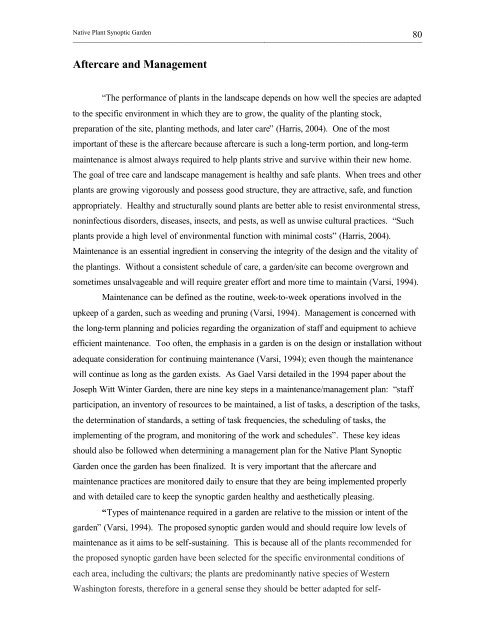Full page photo print - WSU Puyallup Research and Extension ...
Full page photo print - WSU Puyallup Research and Extension ...
Full page photo print - WSU Puyallup Research and Extension ...
Create successful ePaper yourself
Turn your PDF publications into a flip-book with our unique Google optimized e-Paper software.
Native Plant Synoptic Garden<br />
80<br />
____________________________________________________________________________________________________________<br />
Aftercare <strong>and</strong> Management<br />
“The performance of plants in the l<strong>and</strong>scape depends on how well the species are adapted<br />
to the specific environment in which they are to grow, the quality of the planting stock,<br />
preparation of the site, planting methods, <strong>and</strong> later care” (Harris, 2004). One of the most<br />
important of these is the aftercare because aftercare is such a long-term portion, <strong>and</strong> long-term<br />
maintenance is almost always required to help plants strive <strong>and</strong> survive within their new home.<br />
The goal of tree care <strong>and</strong> l<strong>and</strong>scape management is healthy <strong>and</strong> safe plants. When trees <strong>and</strong> other<br />
plants are growing vigorously <strong>and</strong> possess good structure, they are attractive, safe, <strong>and</strong> function<br />
appropriately. Healthy <strong>and</strong> structurally sound plants are better able to resist environmental stress,<br />
noninfectious disorders, diseases, insects, <strong>and</strong> pests, as well as unwise cultural practices. “Such<br />
plants provide a high level of environmental function with minimal costs” (Harris, 2004).<br />
Maintenance is an essential ingredient in conserving the integrity of the design <strong>and</strong> the vitality of<br />
the plantings. Without a consistent schedule of care, a garden/site can become overgrown <strong>and</strong><br />
sometimes unsalvageable <strong>and</strong> will require greater effort <strong>and</strong> more time to maintain (Varsi, 1994).<br />
Maintenance can be defined as the routine, week-to-week operations involved in the<br />
upkeep of a garden, such as weeding <strong>and</strong> pruning (Varsi, 1994). Management is concerned with<br />
the long-term planning <strong>and</strong> policies regarding the organization of staff <strong>and</strong> equipment to achieve<br />
efficient maintenance. Too often, the emphasis in a garden is on the design or installation without<br />
adequate consideration for continuing maintenance (Varsi, 1994); even though the maintenance<br />
will continue as long as the garden exists. As Gael Varsi detailed in the 1994 paper about the<br />
Joseph Witt Winter Garden, there are nine key steps in a maintenance/management plan: “staff<br />
participation, an inventory of resources to be maintained, a list of tasks, a description of the tasks,<br />
the determination of st<strong>and</strong>ards, a setting of task frequencies, the scheduling of tasks, the<br />
implementing of the program, <strong>and</strong> monitoring of the work <strong>and</strong> schedules”. These key ideas<br />
should also be followed when determining a management plan for the Native Plant Synoptic<br />
Garden once the garden has been finalized. It is very important that the aftercare <strong>and</strong><br />
maintenance practices are monitored daily to ensure that they are being implemented properly<br />
<strong>and</strong> with detailed care to keep the synoptic garden healthy <strong>and</strong> aesthetically pleasing.<br />
“Types of maintenance required in a garden are relative to the mission or intent of the<br />
garden” (Varsi, 1994). The proposed synoptic garden would <strong>and</strong> should require low levels of<br />
maintenance as it aims to be self-sustaining. This is because all of the plants recommended for<br />
the proposed synoptic garden have been selected for the specific environmental conditions of<br />
each area, including the cultivars; the plants are predominantly native species of Western<br />
Washington forests, therefore in a general sense they should be better adapted for self-

















